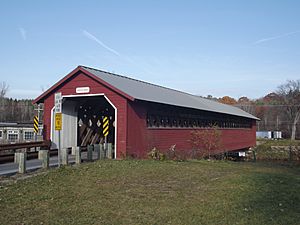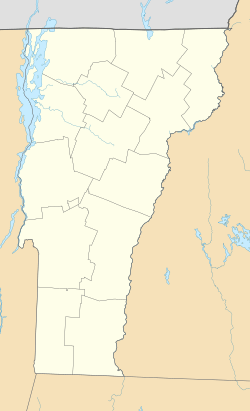Paper Mill Village Bridge facts for kids
Quick facts for kids Paper Mill Village Bridge |
|
|---|---|
 |
|
| Coordinates | 42°54′46″N 73°14′01″W / 42.91278°N 73.23361°W |
| Crosses | Walloomsac River |
| Locale | Town of Bennington, Vermont |
| ID number | VT-02-03 |
| Characteristics | |
| Design | Covered, Town truss |
| Total length | 125 ft 9 in (38.33 m) |
| Width | 14 ft 6 in (4.42 m) |
| Number of spans | 1 |
| History | |
| Designer | Charles F. Sears |
| Construction end | 1889 |
|
Bennington Falls Covered Bridge
|
|
| Nearest city | Bennington, Vermont |
| Area | 1 acre (0.4 ha) |
| Built | 1889 |
| Architect | Sears, Charles F. |
| Architectural style | Town lattice truss |
| NRHP reference No. | 73000185 |
| Added to NRHP | August 28, 1973 |
The Paper Mill Village Bridge is a cool old wooden covered bridge in Bennington, Vermont. People also call it the Paper Mill Bridge or the Bennington Falls Covered Bridge. It helps Murphy Road cross over the Walloomsac River.
This bridge was built way back in 1889. Because it's so old and special, it was added to the National Register of Historic Places in 1973.
Contents
About the Paper Mill Bridge
The Paper Mill Village Bridge is found near an old paper mill building. It's located just off State Route 67A. You can find it northwest of downtown Bennington, close to the Bennington College campus.
Bridge Design and Size
This bridge is a single-span structure. This means it crosses the river in one long section. It uses a special design called a Town lattice truss. This design uses many crisscrossing wooden beams to make the bridge strong.
The bridge is about 125 feet (38 meters) long. It is about 18.5 feet (5.6 meters) wide. The part where cars drive is about 15 feet (4.6 meters) wide, which is enough for one lane of traffic.
How the Bridge is Built
The bridge rests on strong stone supports called abutments. These supports have been partly covered with concrete over time. The sides of the bridge are covered with vertical wooden boards. The ends, where you drive in, have horizontal wooden boards.
The side walls don't go all the way up to the roof. The roof helps protect the upper parts of the wooden trusses. Some of the wooden parts inside have been doubled up. This makes the bridge even stronger. There are also extra beams under the road for support.
History of the Paper Mill Bridge
The Paper Mill Bridge was built in 1889. A man named Charles F. Sears built it. His family was well-known for building bridges in the area.
This bridge is the longest covered bridge in Bennington County. It looks a lot like another nearby bridge called the Silk Covered Bridge. Some people think Charles Sears' father, Benjamin, designed the Silk Bridge. The Paper Mill Bridge was rebuilt in the year 2000 to keep it strong and safe.



